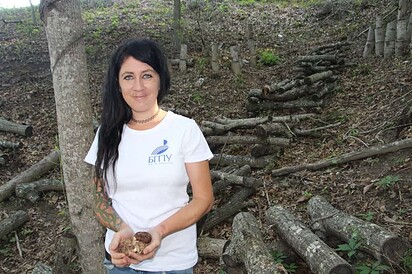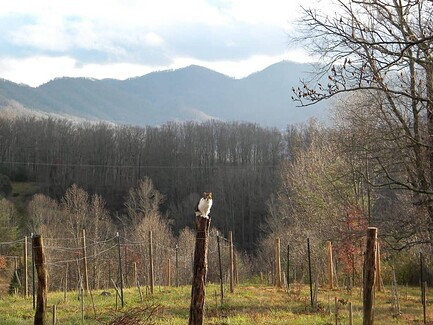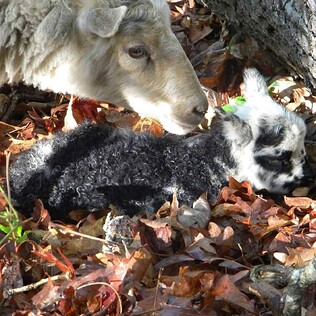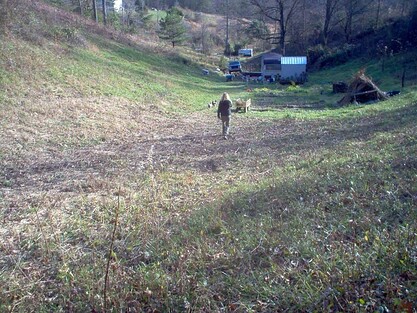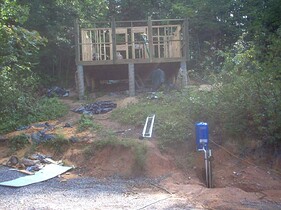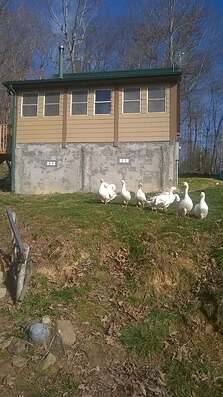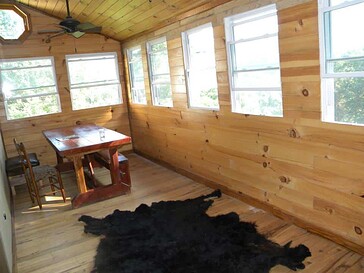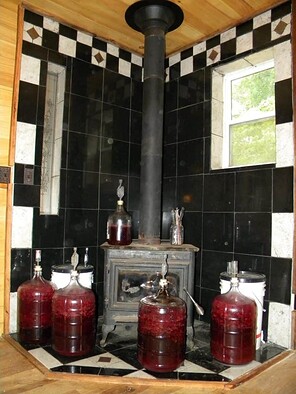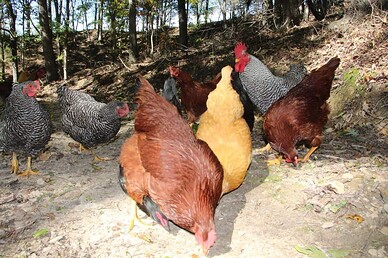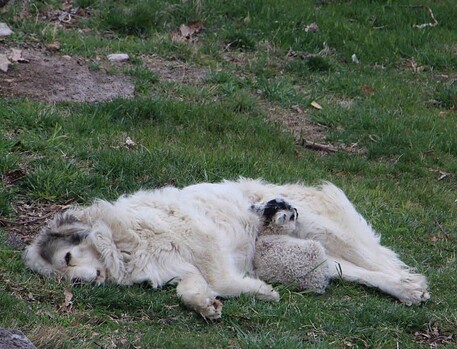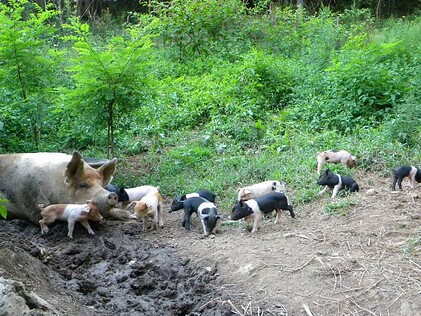Given our intense focus on COVID and its economic repercussions over the past crazy year, we want to make sure we also give sufficient attention in 2021 to the many other topics important to building greater resilience into our lives.
So we'll be adding the voices of other specialists and experts in the future weeks/months as we're able (along with Chris and Adam's regular contributions, of course), guided by the PeakProsperity.com audience's feedback.
Today we hear from Samantha Biggers, who has written regularly over the past decade for a number of homesteading websites.
Many people dream about homesteading on some level.
While having a larger parcel of land is often part of that dream, it's not essential. You can accomplish many homesteading projects while living in the city or the suburbs.
Setting realistic goals for homesteading will make your experience more enjoyable and allow you to get good at the skills you're gaining. Just remember to pace yourself.
Taking on a lot at once doesn't allow for enough time to get good and knowledgeable at any one skill. When you take on too much at once, you are more likely to make mistakes too.
My husband and I started our own homesteading journey in 2008 while in our mid-20s. It was tough. We didn't have much money. But we did have a piece of overgrown land.
Over the past 14 years, we've managed to build a house with no mortgage and get our land producing some crops. The active and fulfilling lifestyle we've had to adopt along the way has made us significantly healthier and happier than most other folks we know. The freedom and independence we've gained homesteading has been wonderful.
In the beginning, I worked for a financial planning firm in Alaska, thanks to an internet connection. But the recession ended that job, so I started writing for online resilience sites.
So, homesteading actually brought me to a full-time job that I thoroughly enjoy.
Our lifestyle also allows my husband and me to help out my father, a disabled Vietnam Veteran.
On top of all that, we're currently expecting our first child. If I hadn't started homesteading, we wouldn't have the peace of mind that having a small but paid for home brings a new family starting out. And since I work from home, childcare shouldn't be an overwhelming expense.
So, I'm a big fan of the benefits of homesteading. Though I don't mean to suggest it's easy.
There were a number of times we felt like giving up. But we kept on. Homesteading on any level is a worthwhile effort. Even a few small homesteading projects will be good for you and your family.
The point of this article is to help you think about your homesteading goals and set realistic ones that will boost your odds of happiness and success. Anyone can be a successful homesteader. The trick is picking the right projects given your resources and abilities and allowing yourself time to learn.
Getting Started
The Myth of Total Self Sufficiency
It is easy to fall for the notion that people in generations past often produced everything they needed.
The truth is that while many came close, there were still items that they needed to get via cash or trade.
They achieved this by specialization. They produced an excess of one or more items to get the cash or barter power to get other items-- such as tea, coffee, sugar, salt, tools, and cloth.
But there are key goods that cash/barter are essential to procure. Virtually no one can produce gasoline, diesel, and kerosene on their homestead.
So start with the understanding that you're not going to be a "lone wolf". You're going to need to interact with and depend on others, to some degree.
Land
You can do a lot of homesteading activities on an acre or less if you plan well. While you may not be able to make your entire living off of a parcel of that size, you can take a bite out of your grocery bill and make your place look nicer.
If you plan on buying a larger property, you need to be careful before putting down your hard-earned cash. Land can be really pretty but not great for certain homesteading activities.
My husband and I were lucky enough to be given just under 11 acres of land in the mountains of NC. My grandfather worked himself to death, but as a result, his children had something to give to their kids. It was and remains an amazing blessing to us.
Our piece of the family land is mostly steep pastures and woods. The wooded half is lightly grazed, but it's not as good as a lush pasture, so you can keep far less livestock per acre. Yet the woodlot does provide us with firewood to heat our home, and we grow gourmet Shiitake, Oyster, and Nameko mushrooms in the understory on logs.
It would be ill-suited for any other purpose besides building some vacation cabins. Even if we cleared the woods, it would not be suitable for extensive gardening and row crops.
Other parts of our property are suitable for gardening and grapes. Some of our sloping pastures have extensive plantings of cold-hardy grapes and blueberries. And the valley where we lived in our camper and the yards around our home include larger gardens. During the pandemic, my husband planted larger garden plots and established more kitchen garden beds near our home.
What I've learned from experience is that when looking for land to buy, don't be misled by the number of acres. A 40-acre parcel in some areas may only have 10 acres or less of land suitable for your homesteading goals.
Generally speaking, flatter and more usable land will cost more, especially in mountainous areas.
Crops & Livestock
Two of the most significant factors to consider when deciding what you can produce on a property are average temperatures and rainfall.
Temperature and precipitation can vary a lot, even within a region. You may have dreams of raising a particular type of livestock or raising a specific crop, but that doesn't mean the land you have and its microclimate are suitable for it.
Twenty miles down the road, the average rainfall may be substantially less than where you live. If you plan on relocating to your new homestead, you need to carefully examine these factors before making the big move.
Let's consider for a moment the argument that you can produce more calories per acre by raising grains rather than grazing cattle.
This opinion is often voiced by people that think you shouldn't be eating a lot of meat. While they are correct that you can grow more calories that way, they fail to see that not all land is suitable for growing grains.
The land my husband and I farm is far too steep for grain production. Erosion would destroy the slopes and pollute the water supply lower down. Using any heavy machinery on the slopes would increase erosion.
We manage to use a small walk-behind tractor by BCS for mowing on slopes and weed-eaters for areas that are too steep for that.
The steepest slopes on our property are only suitable for grazing or some permaculture like blueberries, fruit trees, and grapes.
Budget
As in most of life, real-world costs tend to outpace the plans you put on paper.
So the more you can do to downsize your cost footprint, the more likely you can stick to your budget, or even add to it.
My husband and I started out living in a tent on our property. That lasted just a month or so, then we got a $100 camper that fits in a truck bed and fixed it up. We stayed in that for a few months and then got a larger $300 1978 Holiday Rambler. We had no running water. We had to haul our water about 300 feet. Our electricity was limited to a single electric extension cord running off a temporary pole that was a long-distance away. I had to go down to my Dad's ¼ mile down the road and work from there because I needed a reliable internet connection.
That's what worked for our budget and allowed us to avoid paying rent somewhere else. We put all the money saved from not renting towards building our home.
Though I advise others to consider getting a better RV or trailer to live in than what we had. If you have $5,000-$10,000, that's enough to pick up a used RV and live in that until you build your first structure. If you take care of it, you can resell it to recoup your purchase, or generate income by renting it out. It may sound outrageous, but RVs in Western NC rent for $700 or more per month(!)
When we started building our house in 2009, we had just $1,500 to get started. That doesn't sound like much, but it was enough to dig out our footers with shovels and a power auger, and then buy some supplies like concrete and a mixer.
After that, we just bought materials as we could afford them. We constructed our home one $500 batch of materials at a time.
Hiring others to do your work for you will eat up your budget must faster. Though of course there are times when employing others will be necessary. Some areas may not allow you to do some work legally. Or you may lack the skills or physical ability yourself.
No matter what aspect of homesteading you're budgeting for, always allow at least 10% more because I guarantee you that there will be unexpected expenses, no matter how well you plan.
Assess Your Physical Abilities
A lot of homesteading is not easy work.
How physically fit you are when you start needs to be factored into your initial goals and aspirations.
When my husband and I started, we were in our 20s, but we carried some extra pounds due to living in a colder climate and working office jobs. Working outside and walking up mountains daily resulted in a higher level of physical fitness, but it took some time. You may feel like the work is too much sometimes, but it gets better.
On the other hand, if you're older, disabled, or have underlying health conditions, you need to take this into consideration for your long term homesteading goals. Building a house and running a farm in your 20s and 30s is far different than starting in your 40s or 50s.
There are exceptions, of course. I see 40 and 50-year-olds actually in much better shape to live a homesteading lifestyle than people 20 years younger than them.
Those who are still living a non-homesteading life but want to get started on the path to be more self-sufficient would do well to get started on getting into better shape now. There's zero downside to making that investment in your health, even if you ultimately decide not to become a homesteader.
The Importance Of Skill Development
When my husband and I started homesteading, we had to take our time learning a host of new skills.
Our first butchering experience happened suddenly due to a farm accident. The calf we were raising jumped off the hillside impaling himself on a wooden fence post. Sadly the wound was too bad for him to survive. So we stayed up until 2 am that night butchering.
We weren't set up for it, but luckily we figured out how to hang the cow from a tree and proceed with salvaging the meat. You can do a lot when faced with the sudden threat of losing a lot of your planned future meat supply.
After that experience, we got a few pigs and pastured them while living in our camper. Neither one of us had ever raised pigs, not had ever butchered one. It was quite hard the first time, but got easier every time we did it.
At the start, my husband had some carpentry skills but I had zero construction and building experience. That didn't stop us from building our house, but it sure made the process take longer. All the wiring in our house was done by my husband with me helping. Ten years later, we still haven't experienced any electrical fires!
To learn what to do, we bought books and used them for guides. The good news is that, compared to back then, now there are many more resources to help you learn. YouTube is a treasure-trove of how-to videos on nearly any home project.
The key thing to keep in mind is that you have to give yourself the time to learn, practice, and realize that you will make mistakes.
Remember that with some things, even if you mess it up two or three times, it is still less money out of your pocket than hiring someone else. And you learn a useful skill for later on down the road.
We made all kinds of mistakes but still managed to build a house we love without taking on a mortgage.
Online classes are great for learning homesteading skills. If community colleges have in-person instruction in your area, I advise looking at their listings. Our local community college has affordable classes on everything from blacksmithing to soapmaking and fiber arts.
It's never too early to start gaining skills. Even if you can't start serious homesteading for a few years, you can do a lot now to make yourself much better prepared for when you do.
Gardens
I always advise those with limited garden space to plant the things that will grow in their area but cost the most to purchase at the grocery store.
Consider that organic salad greens and spinach costs around $7 per lb at the local grocery store. Bell peppers are often $1-2 each, depending on their color. These are just a few examples from my region.
Greenhouses and cold frames can help out by allowing you to grow produce out of season or extend your natural growing season.
Container gardens are good for those living in apartments or that want to maximize growing space on their property. For example, you can place planters on patios, stairs or add growing boxes to windows or porch rails.
I plan to write an article on Planning Spring Garden for Peak Prosperity soon. But in the meantime, I recommend checking out this good primer Adam wrote on A How- To Guide For Installing A Home Garden.
Livestock
Most aspiring homesteaders start with chickens, as they are relatively easy to care for and raise, and produce eggs dependably.
You can get started with a few backyard chickens for very little money. Chickens are an easy and kid-friendly addition to a homestead. Gathering eggs is an easy task for them. Many people treat their laying hens like pets. Geese and ducks are other options, but they require more space and care.
A good primer for those considering chickens is Peak Prosperity's guide Raising Your Own Chickens.
Quail are very quiet, so they are popular with urban homesteaders concerned about making too much noise.
We used to raise goats but they are really hard to keep in even a good fence. Sheep are much easier.
Pigs on pasture can be raised without causing a big stink and you get high quality pork. We had our pig bred one year and raised a large litter of piglets. We sold most of the piglets when they were 8 weeks old.
Small Steps Add Up To Big Results
All too often, people discourage themselves before even starting, falsely believing that you need to do everything at once and that it requires a lot of money to get started in homesteading.
Sure, you can get a lot in place if you can afford to throw a big chunk of money into your homesteading dream. But energy, passion and persistence will get you a lot farther in the long run.
Here's a list of things that are achievable right now, based on the space you have.
Apartment Dwellers
- Container Gardens
- Knitting and Sewing
- Canning and Food Preservation
- Soapmaking
- Increasing skills through classes and workshops
- Community garden projects
Suburban Landscapes
In addition to all the things listed for apartment dwellers, those with a small yard should consider the following projects.
- Edible landscaping and small gardens
- Backyard chickens (Check your local laws. Many towns allow for some hens but no roosters)
- Quail
- Small scale aquaculture such as tilapia
1 acre
- Several goats or sheep or a single small breed cow such as a Dexter
- Large garden
- Beehives
- Dwarf Fruit Trees
Larger Parcels
- Sheep, goats, pigs, and cattle
- Larger quantities of single crops. An orchard is one example.
- A market garden for extra income. You can sell excess produce at Farmer's Markets, via Craigslist, or you may be able to contribute to a CSA (Community Supported Agriculture) that sells boxes of locally grown fruits and vegetables.
You can improve the quality of pasture over time if you take care of it. Be sure not to overgraze areas. Overgrazing can do a lot of harm to your land.
How many animals land can support varies a lot by region. For example, it may take as much as 30 acres or even more to support a single full-sized cow in arid areas. Where I live, you can support a single cow on 1-2 acres of decent pasture.
Realistic Home Energy Production Goals
We're lucky to live in a time when it's more affordable than ever to have some backup electricity.
The cost of solar panels has plummeted over the last ten years. You may be interested in other methods of renewable energy such as wind turbines, too.
You must choose the options that are best suited to your climate. Take a look at what others in your area are using. If you see many solar panels and no wind turbines, it would be in your best interest to find out why. It's probably because sunshine is much more reliable than the wind in that area.
I would go so far as to say that solar is the best choice for the vast majority of people reading this.
Wind turbines only work well in areas where there are steady and regular winds. Many turbines will not even start producing power until a minimum wind speed is reached. And areas that are prone to huge gusts are not ideal places to live.
You're not allowed to use wind turbines in some areas. Western North Carolina relies heavily on tourism. You cannot put a wind turbine on a ridge top because it is considered unsightly. On the other hand, in West Virginia, there are many wind turbines on ridge tops because many consider it better than allowing the coal companies to destroy the ridge.
Hydroelectric power is fantastic, but it requires you to have a reliable source of water. You need a spot where water falls well or has the speed to turn a wheel rapidly. In some areas, you may not even have the right to install hydroelectric power on your property. For example, in some areas of Washington State, only the electric company is allowed to use water for power.
If you're looking for property to purchase, you need to ask if you own the water and mineral rights. If you don't, then whoever does own those rights has permission for things to be done on your property that you may not agree with.
There may be laws in your area regarding irrigation, too. For example, you may have a creek or river running through your property but only be allowed to pump so many gallons per year from it to irrigate your crops. In some places, you may not be allowed to do this at all.
Solar energy can produce enough power to run a home but usually not without some sacrifices. For example, most off-grid homes do not use electric appliances such as air conditioners, heaters, or stoves. These appliances draw far too much power. Sure, you could theoretically get enough solar panels and expensive equipment to make it work, but the cost would a lot higher.
Providing your family with some backup power options is a good way to get started with solar. You can add to your system as you learn and can afford it. A small power center and a single solar panel can be purchased for a fairly low cost and allow you to run some small devices during a storm or power outage. The panel can keep the power center charged up during an extended event.
For understanding the best practices for conserving and producing home energy, I recommend reading Peak Prosperity's excellent primer on Home Energy.
Homesteading & Children
Kids can start helping out with some tasks when they are fairly young, but overall, they will demand a lot of your attention and time.
Balancing parenting and homesteading activities is achievable, though. It would be best if you found a way to split up duties and involve your kids. People often use baby carriers and wagons so that they can take their younger children with them while working on the property. A baby carrier allows you to carry them and have your hands free to do other tasks.
Some tasks will be harder to do while trying to watch children. Livestock handling can be dangerous. There are times when you need all your attention to be on the task you are performing.
This is obviously a huge topic in and of itself. If there's enough interest, I'll be happy to write a future article for Peak Prosperity on the benefits and challenges of raising a family on a homestead.
Isolation
Moving to a rural area isn't for everyone.
It can take time to establish friendships and trust in your new community. If you like to socialize, it can be hard to make the adjustment from town to rural. Going to the pub or the grocery store isn't just a quick 5-10 minutes. You will need to plan ou
This is a companion discussion topic for the original entry at https://peakprosperity.com/setting-realistic-homestead-goals/
